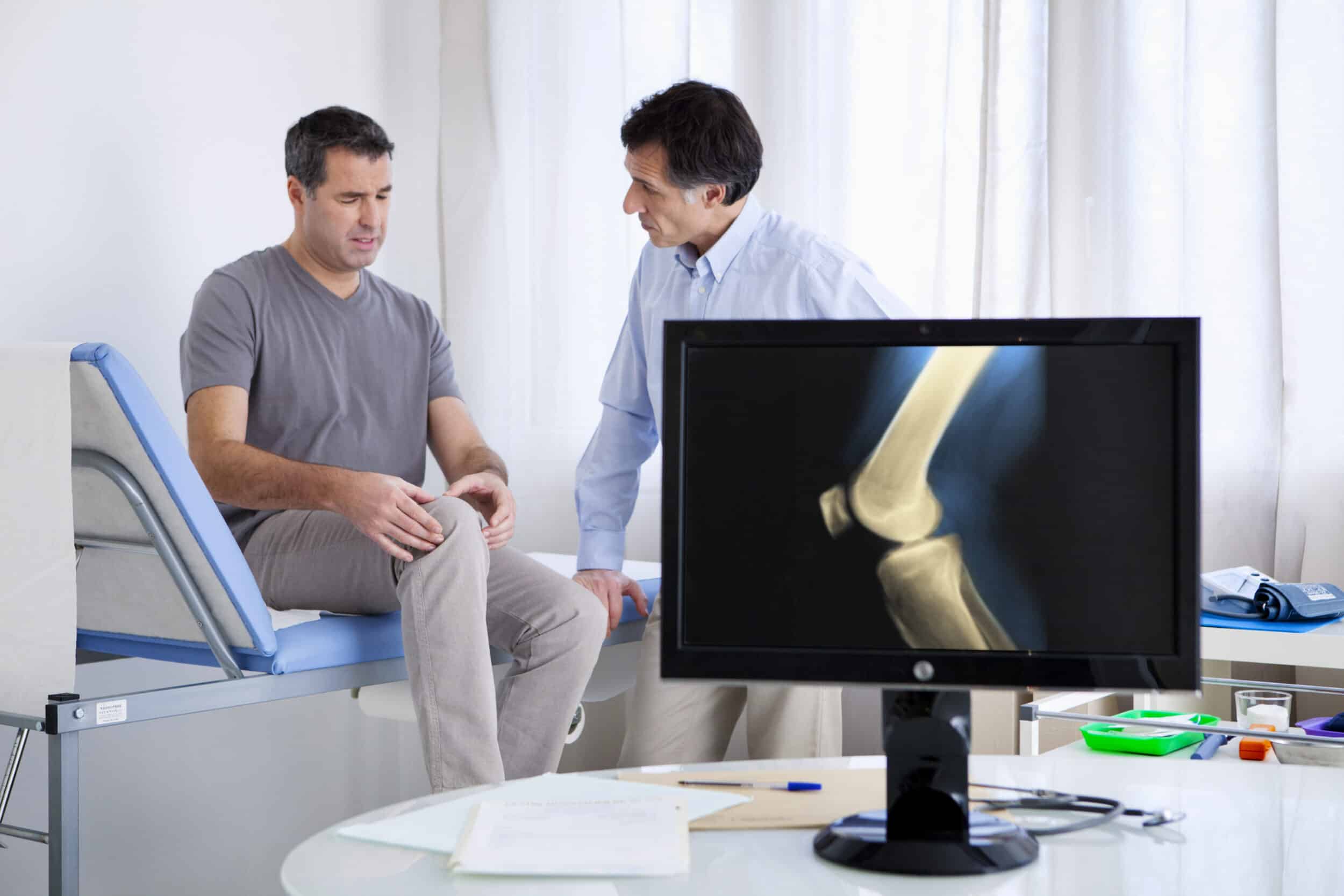Knee Joint Health
Welcome to Granite Orthopaedic’s health education library. The information shared below is provided to you as an educational and informational source only. It is not intended to replace a medical examination or advice given to you by a physician or medical professional.
During total knee replacement surgery, an orthopedic surgeon replaces your damaged knee joint with an artificial joint called a prosthesis. This surgery almost always reduces joint pain and improves your quality of life.

The parts of the prosthesis are secured to the bones of the knee. Together, they form the new joint.
BEFORE YOUR KNEE REPLACEMENT SURGERY
You will most likely arrive at the hospital on the morning of the surgery. Be sure to follow all of your doctor’s instructions on preparing for surgery.
- You should stop eating or drinking 10 hours before surgery.
- If you take a daily medication, ask if you should still take it the morning of surgery.
- At the hospital, a medical team will check your temperature, pulse, breathing, and blood pressure.
- Your medical team may give you an IV to provide fluids and medications needed during surgery.
THE SURGICAL PROCEDURE
When the surgical team is ready, you’ll be taken to the operating room. The medical team will give you anesthesia to help you sleep through surgery or to make you numb from the waist down.
Your surgeon will begin by making an incision on the front or side of your knee. They'll remove any damaged bone and then put the new joint into place. The surgeon closes the incision with surgical staples or stitches.
AFTER YOUR KNEE REPLACEMENT SURGERY
After surgery, you’ll be sent to the PACU (postanesthesia care unit). When you are fully awake, the medical team will move you to your room, and the nurses will give you medications to ease your pain.
Medical staff may insert a catheter into your bladder if necessary. They may also utilize special machinery on your knee and leg to prevent it from getting stiff and to prevent blood clots. Your healthcare providers will eventually help you get up and moving.
WHEN TO CALL YOUR DOCTOR

Once at home, call your doctor if you have any of the symptoms below:
- An increase in knee pain
- Pain or swelling in a calf or leg
- Unusual redness, heat, or drainage at the incision site
- Fever of 101.0°F or higher
- Trouble breathing or chest pain (call 911)
TOTAL KNEE REPLACEMENT FAQ
HOW PAINFUL IS THE PROCEDURE?
You will experience some discomfort from your total knee replacement surgery. At Granite Orthopaedics, our orthopedic surgeons use advanced techniques to minimize pain during and immediately after the surgery. Your medical team will provide postoperative pain management strategies tailored to your needs, ensuring a more comfortable recovery process.
WHAT ARE THE BENEFITS OF A KNEE REPLACEMENT?
The primary benefit of total knee replacement is significant relief from knee pain and debilitating arthritis. This procedure enhances your mobility and quality of life by restoring the function of the knee. Patients often experience improved movement within weeks, allowing them to return to everyday activities with less pain.
HOW DIFFICULT IS THE REHABILITATION OF THE KNEE?
Rehabilitation following knee surgery is crucial for successful recovery and the best possible outcome. While the process can be challenging, it’s worth the effort. Our team will guide you through graduated exercises designed to strengthen the knee and improve flexibility. We also have physical and occupational therapists on staff. Most patients find that they can resume normal activities within a few months, with ongoing improvements for up to a year.
WHAT SHOULD YOU AVOID AFTER YOUR PROCEDURE?
You should avoid certain activities to ensure proper healing from your total knee replacement, such as:
- Running and jumping
- Excessive bending of the knee
- Lifting heavy objects.
Your medical team will provide detailed postoperative care instructions.
CAN YOU GET BOTH KNEES REPLACED AT THE SAME TIME?
Bilateral knee replacement, or replacing both knees at the same time, is possible and may be recommended for patients who suffer from severe arthritis in both knees. This approach has the advantage of a single recovery period. Talk with your orthopedic surgeon to determine if this option suits your health profile and recovery goals.
WHICH DAY IS THE WORST AFTER KNEE SURGERY?
The first few days following knee surgery can be the most challenging regarding pain and mobility. Most patients report the second day after surgery as the most difficult. Our team in Prescott Valley prioritizes your pain management and mobility support from day one to help manage discomfort.
WHAT IS THE RECOVERY PERIOD FOR TOTAL KNEE REPLACEMENT?
Recovery time can vary after total knee replacement, but most patients start to walk with assistance the day after surgery. For the first six weeks, you’ll be focused on reducing swelling and starting some mobility exercises. From weeks six to 12, you’ll continue to rebuild strength and mobility. Most people achieve significant pain relief and functional improvement in about three to six months, but complete recovery can take 12 months or more.
WHAT ARE THE RISKS OF A TOTAL KNEE REPLACEMENT?
The total knee replacement success rate is high, with about 90% of replaced knees still functioning well after 15 years. But it’s still important to understand the risks, which can include:
- Infection
- Blood clots
- Knee stiffness
- Prosthetic issues
Our surgeons are committed to minimizing these risks with meticulous techniques and thorough postoperative care.
SCHEDULE A CONSULTATION WITH THE BEST ORTHOPEDIC SURGEONS IN CENTRAL ARIZONA
At Granite Orthopaedics, we're not just a clinic; we're a team of the top total knee replacement surgeons in Prescott Valley, Arizona. We specialize in state-of-the-art joint replacement therapies tailored to each patient's needs. Our expertise in the latest surgical techniques and a commitment to personalized postoperative care ensure that we provide you with the best possible outcome.
Don’t wait to reclaim your mobility and enhance your quality of life. Schedule your consultation today by calling 928-777-9950 and find out why we are the trusted choice for total knee replacement. Take the next step towards a life free from knee pain.
